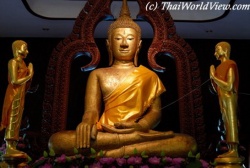3 Unified Silla period: reconciliation of doctrinal disputes
Unified Silla period: reconciliation of doctrinal disputes
One of the most important proponents of this syncretic approach was the noted monk and scholar Wônhyo. In his view, the various disputes which arose among Buddhist scholars were similar to the story of the blind men’s description of an elephant: each man was only defining one aspect of the animal. In one sense, they were all wrong, because each failed to fully describe the elephant. In another sense, however, they were not entirely wrong, as what they were describing was not something other than the elephant.
Wônhyo was not interested in merely partial or incomplete understandings, however; rather, he focused on integrating a variety of doctrines into one complete view, as seen from a higher perspective. This view has been termed hwajaeng, or the ‘reconciliation of doctrinal controversy’. The hermeneutical device used in this doctrinal reconciliation is well represented in his unique genre of Buddhist commentarial work, chong-yo, as well as in his concepts of kae (unfolding or opening) and hap (folding or sealing) the truth. Wônhyo is believed to have composed approximately seventeen of these chong-yo, of which only five are extant. Chong translates as doctrine or theme, and yo means essence. Thus, for example, one of his works, the Yolban’gyong chongyo, translates as the ‘Doctrinal Essentials of the Nirvāṇa Sutra’. Here, ‘doctrine’ refers to the various ideas which are discussed, and ‘essentials’ integrates them into one primary framework of thought. Similarly, by his usage of the word ‘unfolding’ (kae), Wônhyo indicates a variety of ideas and analyses, while through ‘folding’ (hap) he denotes how these themes may be synthesized into one cohesive unit of understanding. Doctrine, then, reflects the unfolding of the one into the many, whereas essence refers to the folding of the many back into the one.
Another device which Wônhyo used in order to reconcile opposites and thus denote their non-duality was his theory of essence-function (Korean: ch’e-yong) (see Ti and yong). In his Taesung kisillon so (Treatise on Awakening Mahāyāna Faith) he asserts that Mahāyāna is a synonym for One-Mind. This One-Mind represents essence, or ch’e, while the variety of mental and physical states, or the arising of dharmas, represents function, or yong. In terms of its internal logic, essence-function is no different from the kae-hap (folding and unfolding) formulation. According to Wônhyo, when the essence of Mahāyāna, or One-Mind, is unfolded, immeasurable and limitless meaning can be found in its doctrine. Conversely, when the doctrine is folded, it returns to its essence, which consists of two aspects: the absolute and the phenomenal. The limitless meanings of One-Mind are identical to this essence and are completely amalgamated within it. Therefore, One-Mind unfolds and folds freely, and establishes and refutes without restrictions.
In this way, the myriads of sensory impressions are brought to a permanent end and return to the source of One-Mind. Thus, there is nothing that is not advocated and nothing that is not refuted. Wônhyo calls the advocacy concession or acceptance (hwanho), and he labels the refutation variously as deprivation (t’al), negation (kyon), return (wang) or prohibition (purho).
Wônhyo was particularly concerned with using his hermeneutic tools to reconcile the Mādhyamika and Yogācāra doctrines. In his view, Nāgārjuna’s Mūlamadhyamakaśāstra and Dvādaśanikāyaśāstra offer a thorough dialectic critique of all views which a person might advocate, to the extent that they abolish both the views refuted and the act of refutation (see Nāgārjuna). However, because Mādhyamika dialectics do not affirmatively acknowledge both the subject and object of this refutation, the approach is purely negative, and thus nothing is established. On the other hand, the Yogācāra school accomplishes a thorough analysis of all mental states and accordingly establishes both the shallow and profound teachings. However, because the Yogācārins do not continue on to refute what they have established, theirs is a purely positive approach, and thus, nothing is refuted. Doctrinal controversy arose between the two schools due to the fact that the Mādhyamikas attached to refutation and deprivation, whereas the Yogācārins attached to establishment and acceptance. Each recognized only a part of the truth; although neither was entirely wrong, at the same time neither was altogether correct.
Wônhyo was able, based on his unique usage of unfolding and folding, to reconcile these differences by including them into a single Buddhist teaching, that of One-Mind, which allows for both affirmation and negation. According to Wônhyo, the Taesung kisillon, a noted Mahāyāna text upon which he based his well-known commentary, is a syncretic work which embraces the positions of both Mādhyamika and Yogācāra (see Awakening of faith in Mahāyāna). He asserts that while it refutes all relative views (as represented by the two above-mentioned schools), it also embraces them comprehensively within the all-encompassing One-Mind.


